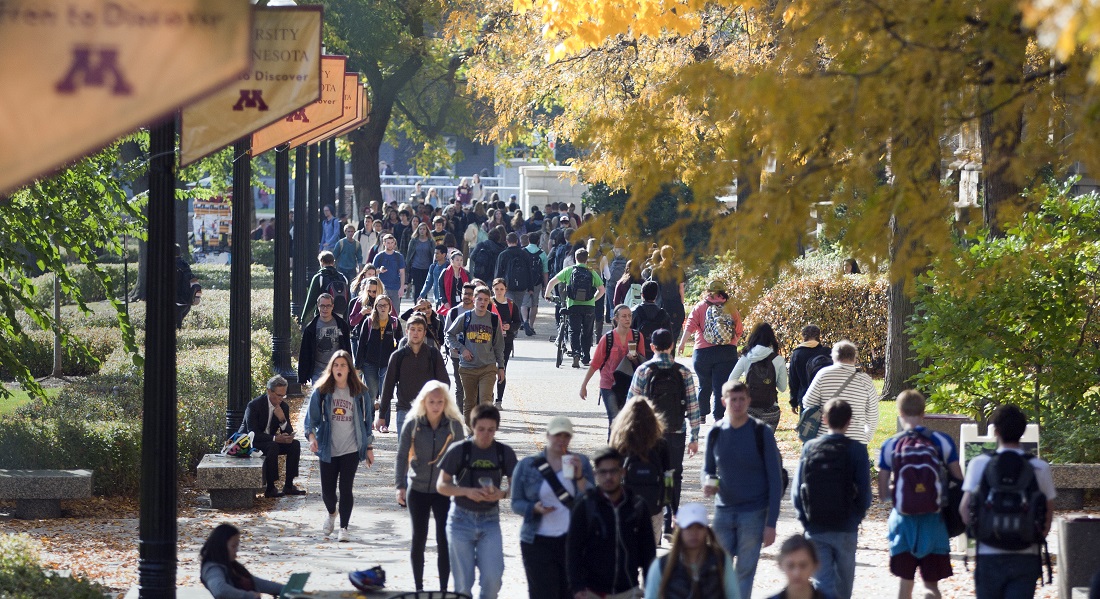Minnesota’s higher ed enrollment is up, but officials say gaps remain to reach 2025 target

It looks like the losing streak is over.
After 14 years of declining enrollment at Minnesota’s postsecondary schools, the National Student Clearinghouse estimates that undergraduate enrollment in Minnesota increased 1.2% in the most recent academic year.
The House Higher Education Finance and Policy Committee received that good news on Thursday but learned there is much work to do to reach a goal signed into law in 2015: That 70% of the state’s residents between the ages of 25 and 54 will have earned a certificate, associate, or bachelor's degree by 2025.
Dennis Olson, commissioner of the Office of Higher Education, said that it’s estimated the state is up to 63% with two years to go. And that — while all basic race groups saw increases in earning degrees and certificates over the past eight years — Black and Hispanic residents have far lower percentages than their white and Asian counterparts.
[MORE: View his presentation slides]
According to estimates from the Minnesota Demographic Center based on U.S. Census information, 40.5% of Minnesota’s Black residents and 35.5% of its Hispanic residents between ages 25 and 54 have earned a degree or certificate, compared to 68.7% of white residents and 64.3% of those who identify as Asian.
The state’s Office of Higher Education estimates that – to reach the 70% mark – Black and Hispanic students will have to see substantial increases in enrollment. How do they hope to make this happen? At Thursday’s meeting, much attention was given to two new programs that were signed into law in 2023: The North Star Promise and Direct Admissions.
The North Star Promise covers tuition and fees for any qualifying student from a household with a family adjusted gross income of $80,000 or less. It’s a “last dollar” grant program, meaning that it will cover the remaining balance of tuition and fees after other scholarships, grants, stipends and tuition waivers have been applied. It does not cover books, supplies, food, housing or transportation.
The Office of Higher Education estimates that the program will impact 15,000 to 20,000 students in the first academic year, which begins this fall.
Direct Admissions is a program that contacts high school students with a personalized list of colleges and universities committed to admitting them based on their academic performance through the end of their junior year.
OIson said North Dakota, South Dakota and Wisconsin are in the process of developing similar programs to either the North Star Promise or Direct Admissions.
Rep. Marion Rarick (R-Maple Lake) suggested that the state consider moving its degree attainment goal for 2025 to an ensuing year because of the difficulties caused by the pandemic. Olson responded that he “wholeheartedly agreed” that such a change in statute should be considered.
Rep. Nathan Coulter (DFL-Bloomington) said a state statute dictates it to be the Legislature’s policy to fund two-thirds of a student’s tuition and fees at the University of Minnesota, and asked Olson how close the state currently is to that goal. Olson replied that it’s been in the 50% range for decades.
Related Articles
Search Session Daily
Advanced Search OptionsPriority Dailies
Ways and Means Committee OKs proposed $512 million supplemental budget on party-line vote
By Mike Cook Meeting more needs or fiscal irresponsibility is one way to sum up the differences among the two parties on a supplemental spending package a year after a $72 billion state budg...
Meeting more needs or fiscal irresponsibility is one way to sum up the differences among the two parties on a supplemental spending package a year after a $72 billion state budg...
Minnesota’s projected budget surplus balloons to $3.7 billion, but fiscal pressure still looms
By Rob Hubbard Just as Minnesota has experienced a warmer winter than usual, so has the state’s budget outlook warmed over the past few months.
On Thursday, Minnesota Management and Budget...
Just as Minnesota has experienced a warmer winter than usual, so has the state’s budget outlook warmed over the past few months.
On Thursday, Minnesota Management and Budget...